Some of the information on this Web page has been provided by external sources. The Government of Canada is not responsible for the accuracy, reliability or currency of the information supplied by external sources. Users wishing to rely upon this information should consult directly with the source of the information. Content provided by external sources is not subject to official languages, privacy and accessibility requirements.
Any discrepancies in the text and image of the Claims and Abstract are due to differing posting times. Text of the Claims and Abstract are posted:
| (12) Patent Application: | (11) CA 2016489 |
|---|---|
| (54) English Title: | PROCESS AND AN APPARATUS FOR PASTEURIZING AND PRECOOKING UNCOOKED PIZZA BASES |
| (54) French Title: | PROCEDE ET APPAREIL POUR LA PASTEURISATION ET LA PRECUISSON DE BASES DE PIZZA NON CUITES |
| Status: | Deemed Abandoned and Beyond the Period of Reinstatement - Pending Response to Notice of Disregarded Communication |
| (51) International Patent Classification (IPC): |
|
|---|---|
| (72) Inventors : |
|
| (73) Owners : |
|
| (71) Applicants : |
|
| (74) Agent: | BORDEN LADNER GERVAIS LLP |
| (74) Associate agent: | |
| (45) Issued: | |
| (22) Filed Date: | 1990-05-10 |
| (41) Open to Public Inspection: | 1990-11-22 |
| Availability of licence: | N/A |
| Dedicated to the Public: | N/A |
| (25) Language of filing: | English |
| Patent Cooperation Treaty (PCT): | No |
|---|
| (30) Application Priority Data: | ||||||
|---|---|---|---|---|---|---|
|
Abstract
A Process and an apparatus for pasteurizing and precook-
ing uncooked pizza bases
A vitroceramic plate is heated by microwaves to bring
it to a temperature of 250 to 300°C, the plate is then re-
moved from the microwave field and the pizza base is placed
on the plate for about 2 to 3 minutes. The arrangement
comprises a conveyor belt (1) with a plurality of vitro-
ceramic plates (2) and with a zone in which it passes
through a microwave tunnel (4) and a zone in which it
passes through open air.
Fig.
Note: Claims are shown in the official language in which they were submitted.
Note: Descriptions are shown in the official language in which they were submitted.

2024-08-01:As part of the Next Generation Patents (NGP) transition, the Canadian Patents Database (CPD) now contains a more detailed Event History, which replicates the Event Log of our new back-office solution.
Please note that "Inactive:" events refers to events no longer in use in our new back-office solution.
For a clearer understanding of the status of the application/patent presented on this page, the site Disclaimer , as well as the definitions for Patent , Event History , Maintenance Fee and Payment History should be consulted.
| Description | Date |
|---|---|
| Inactive: IPC deactivated | 2016-03-12 |
| Inactive: IPC from PCS | 2016-01-09 |
| Inactive: IPC expired | 2016-01-01 |
| Inactive: IPC from MCD | 2006-03-11 |
| Inactive: IPC from MCD | 2006-03-11 |
| Inactive: IPC from MCD | 2006-03-11 |
| Inactive: IPC from MCD | 2006-03-11 |
| Inactive: IPC from MCD | 2006-03-11 |
| Application Not Reinstated by Deadline | 1998-05-11 |
| Time Limit for Reversal Expired | 1998-05-11 |
| Deemed Abandoned - Failure to Respond to Maintenance Fee Notice | 1997-05-12 |
| Inactive: Abandon-RFE+Late fee unpaid-Correspondence sent | 1997-05-12 |
| Application Published (Open to Public Inspection) | 1990-11-22 |
| Abandonment Date | Reason | Reinstatement Date |
|---|---|---|
| 1997-05-12 |
Note: Records showing the ownership history in alphabetical order.
| Current Owners on Record |
|---|
| SOCIETE DES PRODUITS NESTLE S.A. |
| Past Owners on Record |
|---|
| EBERHARD RAETZ |
| TOAI LE VIET |